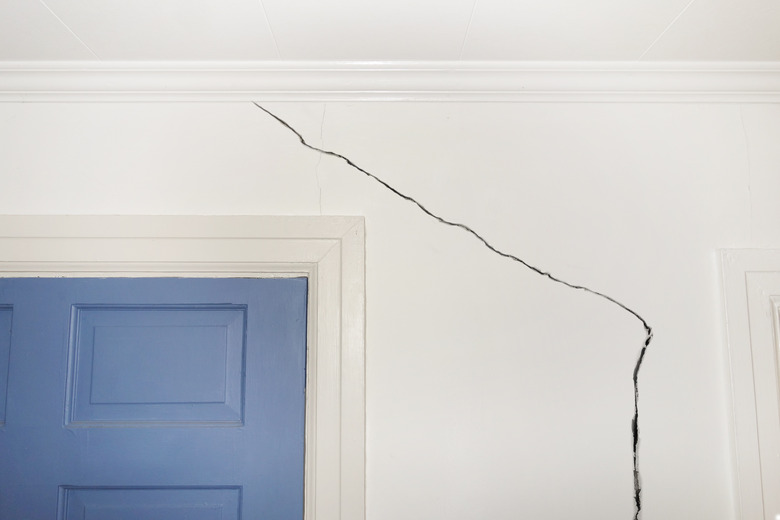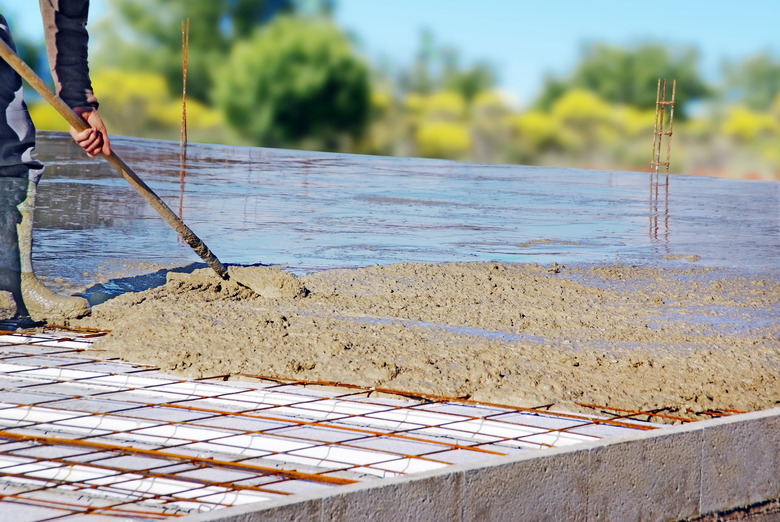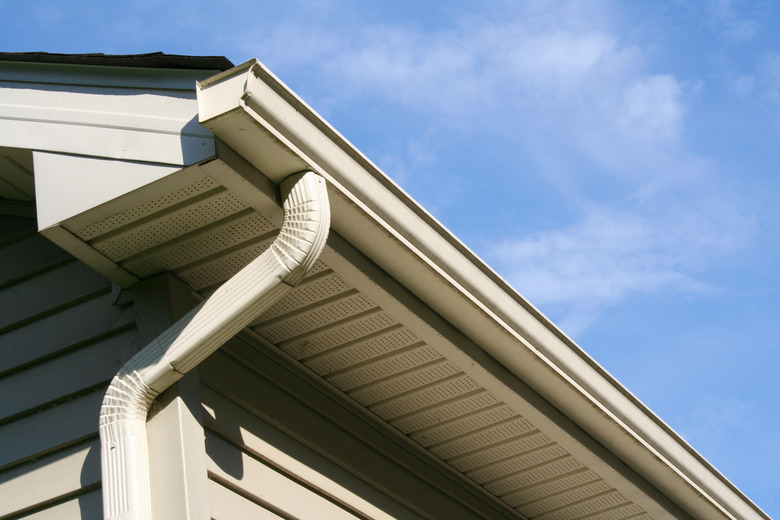10 DIY Tips To Make A Home Earthquake-Resistant
We may receive a commission on purchases made from links.
Building codes have changed significantly over the years, and newer homes are much more earthquake-resistant than those built prior to 2000, when the International Building Code adopted provisions from the National Earthquake Hazards Reduction Program. That doesn't mean you're good to go, however, if your home was built after 2000 — because all homes are subject to earthquake damage no matter how strongly they are constructed. But, there's a better chance your home will survive intact.
What happens inside the house is another matter. The bulk of injuries suffered during an earthquake — as demonstrated by a study following the 1994 Northridge earthquake in the Los Angeles area — are caused by falling objects, and only about 1 percent are attributable to building damage. So, while doing a structural seismic retrofit to your older house may make damage mitigation easier, it won't protect you or your family from injury if you haven't made the interior of your house earthquake-resistant.
That isn't to say you should pass on doing structural retrofits to your house. A house that isn't firmly anchored to the foundation can simply slide off it, breaking plumbing and gas pipes in the process and creating the possibility of devastating fires that may rage for hours before overburdened firefighters can get to them. Fires often do more damage than the earthquake itself, which happened in San Francisco in 1906, Tokyo in 1923 and Kobe, Japan in 1995 among other places. You can prevent much of this damage with a structural retrofit, which is a job you can do yourself. All in all, there are 10 ways to prepare for the big one and make your home more earthquake-resistant.
1. Assess the Need for Earthquake Insurance
1. Assess the Need for Earthquake Insurance
Contrary to popular opinion, living in a notorious seismic zone, such as California, Alaska or Hawaii, is not a prerequisite for experiencing a powerful tremor. The U.S. Geologic Survey identifies 16 states at high risk for experiencing a damaging earthquake in the next 50 years, which includes (besides the three already mentioned):
- Arkansas
- Idaho
- Illinois
- Kentucky
- Missouri
- Montana
- Nevada
- Oregon
- South Carolina
- Tennessee
- Utah
- Washington
- Wyoming
Even if you don't live in one of these states, you aren't out of the woods because all but eight states have experienced at least one strong earthquake in the period from 1974 to 2003, and who's to say that those states that haven't experienced one aren't simply overdue? The earth's crust may be solid, but at the same time, it's also fluid and unpredictable.
Risks are obviously higher in seismic zones, however, and homeowners living there should consider earthquake insurance, which is not provided with a standard home policy. Insurers typically hire structural engineers to evaluate the structural integrity of houses as well as the surrounding topography and soil conditions. People on hillsides should consider the possibility of landslides, and those in coastal areas have to be ready for tsunamis. An important part of earthquake preparedness is having an evacuation route planned and knowing where you're going to shelter.
2. Make the Structure Earthquake-Resistant
2. Make the Structure Earthquake-Resistant
On average, it costs between $3,000 and $5,000 to earthquakeproof a house that was built before 2000, and for a house in reasonable shape with a solid foundation in a seismic zone, it's money well spent. However, if you're on a budget and reasonably handy, you can do the job yourself.
It generally consists of two procedures: bolting the building's sill plates to a reinforced concrete foundation with anchor bolts and strengthening the cripple walls, which are the short walls that extend from the foundation to the first floor, with structural sheathing (not all homes have cripple walls). You can often do the entire job from inside the crawl space, but in some cases, you may have to remove some drywall to access the sill plates.
Retrofitting a home on a post-and-pier foundation is usually more labor intensive because it typically involves pouring a new footing and building new cripple walls around the perimeter to connect the structure to the footing. In addition, homes with a living space situated over a garage need extra work because the upper story, known as a soft story, is more vulnerable to structural damage because of the open space created by the garage door. The walls surrounding the garage door need to be reinforced with sheathing, and sometimes, the garage door frame has to be replaced with a stronger one.
3. Reinforce the HVAC System
3. Reinforce the HVAC System
A typical HVAC system consists of large components that can slide or tip over during a quake, and that movement is likely to shatter the PVC vent and drain pipes that service high-efficiency furnaces as well as damage gas lines, creating the potential for fire. To reduce the likelihood of this happening, the pipes should all be fitted with flexible connectors or short lengths of flexible pipe to provide some freedom of movement. An even better option available to homeowners willing to move or replace their equipment is to install isolators, which are springlike devices that can absorb movement, underneath the large components and secure the components to the isolators with restraint brackets.
4. Strap or Replace the Water Heater
4. Strap or Replace the Water Heater
If the water heater falls over during an earthquake, the result is broken gas and electrical connectors, flooding in the water-heater room and general mayhem. This is one of the most preventable consequences of natural disasters, like earthquakes, because all you have to do is strap the water heater to the wall. Unlike a structural retrofit, you can do this job yourself with straps you can find at any home improvement center. An even better idea is to replace your tank-style water heater with a tankless on-demand model that you can attach to a reinforced wall.
5. Fit Gas Appliances With Flexible Connectors
5. Fit Gas Appliances With Flexible Connectors
All gas appliances in the kitchen, laundry room and elsewhere should have flexible hose connectors that won't break if the appliances move. If you've already had an automatic gas shutoff valve installed by a licensed gas technician or your utility company, these may seem redundant, but they aren't because they prevent damage to the gas pipes. Be sure to shut off the main gas supply when installing them and seal them with tape approved for gas fittings unless you purchase fittings designed for use without tape.
6. Reinforce, Replace or Eliminate the Chimney
6. Reinforce, Replace or Eliminate the Chimney
A house with a brick or stone chimney will never get an "A" on its earthquake preparedness report card because the chimney is usually the first thing to go in an earthquake, and it can rain debris onto the roof and the ground below. If you don't use your fireplace, it's a good idea to remove the chimney or plug it with a steel pipe filled with concrete. If you do use the fireplace, consider replacing the brick and stone with a steel chimney liner enclosed in plywood or fiber cement siding. You may have no other option than to leave the chimney as it is, in which case, you should reinforce the roof around the chimney with an extra layer of plywood to absorb the weight of falling bricks.
7. Stabilize Cinder-Block Walls
7. Stabilize Cinder-Block Walls
Many homes have cinder-block walls in the yard, in outbuildings and even in the basement or crawl space, and it's important to reinforce these with concrete and rebar to prevent them from falling over in an earthquake. An unreinforced retaining wall could also collapse, possibly resulting in a landslide or worse. You can reinforce it by driving lengths of rebar through the holes that overlap when the blocks are stacked and filling the holes with concrete.
8. Make the Kitchen Earthquake-Resistant
8. Make the Kitchen Earthquake-Resistant
If you take no steps to prepare your kitchen for an earthquake, the entire contents of the cupboards, kitchen shelves and refrigerator will end up in the middle of the floor, and it will be full of broken glass. To prevent this:
- Move all heavy items to lower shelves.
- Put nonslip liners in the cupboards and on the shelves.
- Secure the refrigerator to the wall using a refrigerator fastening kit.
- Install raised ledges on the fronts of shelves or countertops on which there are heavy appliances, such as microwaves, juicers or coffeemakers.
- Install earthquake cabinet latches on all the cabinet doors. These lock during an earthquake but are not activated by normal activity, even if you slam the doors.
9. Batten Down the Hatches Indoors
9. Batten Down the Hatches Indoors
Considering that falling objects and moving furniture cause the bulk of injuries during an earthquake, it's important to make your living areas earthquake-resistant by securing items so they won't fall or moving them out of the way.
- Secure bookcases to the wall with corner brackets. Use a stud finder to locate studs for the brackets; don't simply attach them to the drywall with anchors.
- Make sure the electrical boxes for ceiling light fixtures are attached to ceiling joists and not just to the drywall. This may require moving fixtures a few inches to one side or the other.
- Move heavy objects away from beds.
- Secure vases, pictures and other heavy or breakable items to surfaces with earthquake putty, also called museum putty.
- Cover windows with shatter-resistant film to minimize the possibility of flying shards of glass.
10. Earthquakeproof the Outside of the House
10. Earthquakeproof the Outside of the House
The gutters aren't the first thing that springs to mind when thinking about earthquakes, but if they are full and water is spilling over, it could be undermining the foundation, making it more likely that it will move or suffer damage. Cleaning the gutters may be enough, but if runoff still collects around the foundation, you may want to install a perimeter drain or rent a mini dozer and regrade the land around the house. This could be an opportunity to improve the landscape and increase the real estate value of your home.
The chief hazards outdoors during an earthquake are from falling objects, so remove dead trees and secure or remove rickety old outbuildings and dilapidated fences. If you have a high deck, the posts should be secured with diagonal braces that run from the top of one post to the base of another. There isn't much you can do to prepare a concrete swimming pool for an earthquake, but if you're thinking of installing a new pool, consider fiberglass, which is more flexible and much less likely to crack.
References
- HomeLight: How to Earthquake-Proof Your House for Safety: A Rock-Solid Guide
- Military.com: Tips To Make Your Home Earthquake Ready
- Statista: Number of Strong Earthquakes in the U.S. from 1974 to 2003, by State
- Earthquake Country Alliance: Step 1: Secure Your Space
- PropTiger: How To Make Your House Earthquake Resistant



